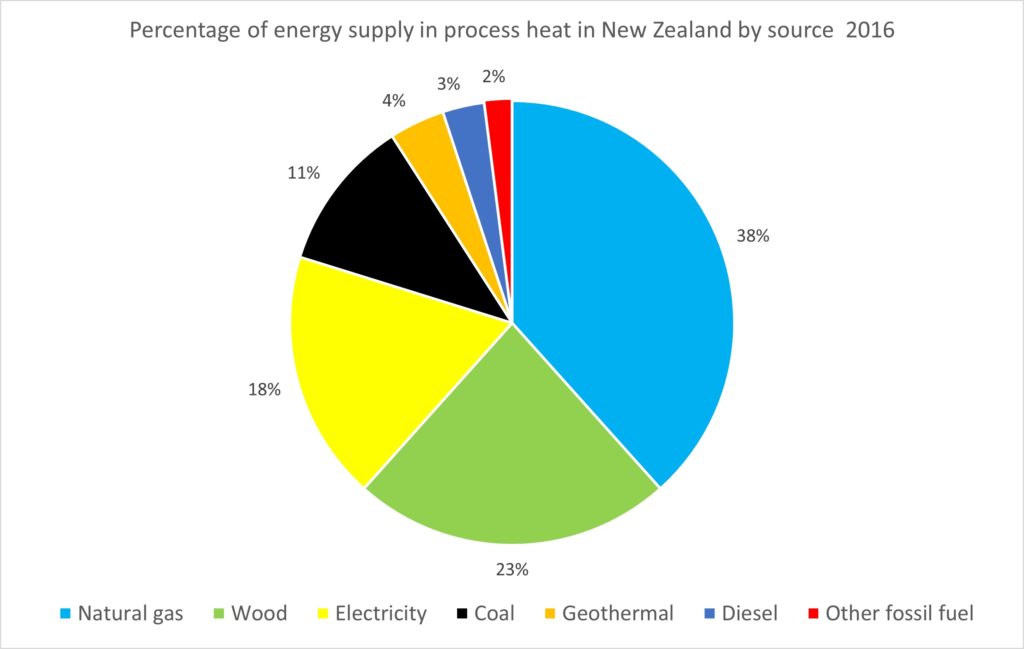What energy sources power our factories?
New Zealand’s industrial sector spans activities such as timber processing, steel production, preparing milk and red meat for export markets, and basic materials like cement and lime.
The majority of the energy for these sectors comes from fossil fuels, noting most large industrial energy users are actively looking for low emissions alternatives. This is partly because of evolving government climate change policy, and also due to the changing demands of their customers and markets.
In descending order, New Zealand’s process heat comes from natural gas, wood, electricity, coal, geothermal, diesel, and other fossil fuel – in total about 54% based on 2016 figures[1] – the most recent comprehensive government analysis of industrial process heat took place in 2017.

The largest source of renewable energy used in providing industrial process heat, wood, is used overwhelmingly in the wood processing industry[2].
In almost all sectors outside of wood processing, the reliance on fossil fuels is much greater.
These figures were compiled by the Ministry of Business, Innovation, and Employment in 2017[3] based on information from the 2016 year.
An equally comprehensive assessment of data would be required to quantify whether or to what extent the nation’s industrial energy profile has changed since then. The table below gives the most up to date comprehensive government figures for fuel and energy supply across New Zealand’s industrial sector. As the most recent such assessment, these figures paint the clearest picture possible.
The heavy reliance on fossil fuels outside of the wood processing sector is mainly due to a lack of viable alternatives.
| Sector | Percentage of energy derived from fossil fuels in 2016 |
| Dairy product manufacturing | 92.00% |
| Meat product manufacturing | 92.00% |
| Petroleum, chemical, and rubber manufacturing | 97.30% |
| Non-metallic mineral product manufacturing | 90.40% |
| Indoor (hothouse) covered vegetable growing | 87.25% |
| Other food and beverages | 92.50% |
The figures per sector are broken down in the tables below.
Dairy processing energy supply 2016[4]
| Energy supply | Percentage of energy consumption |
| Coal | 54.00% |
| Natural gas | 38.00% |
| Other (liquid fuels, geothermal, wood, electricity) | 8.00% |
Meat product manufacturing energy supply 2016[5]
| Energy supply | Percentage of energy consumption |
| Natural gas | 61.00% |
| Coal | 31.00% |
| Other (LPG, fuel oil, and wood). | 8.00% |
Indoor hothouse energy supply 2016[6]
| Energy supply | Percentage of energy consumption |
| Natural gas | 46.70% |
| Coal | 33.80% |
| Geothermal | 12.50% |
| Diesel | 7.00% |
Other food and beverages energy supply 2016[7]
| Energy supply | Percentage of energy consumption |
| Natural gas | 47.40% |
| Diesel | 30.30% |
| Coal | 10.70% |
| Electricity | 10.10% |
| Other fossil fuels | 1.40% |
| Wood | 0.20% |
Petroleum, chemical, and rubber manufacturing energy supply 2016[8]
| Energy supply | Percentage of energy consumption |
| Natural gas | 74.10% |
| Ex-crude (refinery produced oil) | 21.80% |
| Electricity | 3.20% |
| Other | 0.90% |
Non-metallic mineral manufacturing 2016[9]
| Energy supply | Percentage of energy consumption |
| Coal | 46.20% |
| Natural gas | 23.90% |
| Other fossil fuels | 20.00% |
| Wood | 7.00% |
| Electricity | 3.00% |
Wood processing energy supply 2016[10]
| Energy supply | Percentage of energy consumption |
| Wood (including black liquor) | 79.10% |
| Natural gas | 9.60% |
| Geothermal | 7.50% |
| LPG | 1.20% |
| Coal | 1.00% |
| Electricity | 1.00% |
| Other (fuel oil, diesel) | 0.40% |
In recent years there have been several rounds of government policy consultation in which feedback has been sought from the public on what feasible options exist for reducing and eventually eliminating the use of fossil fuels in New Zealand’s industrial sector.
The most recent rounds of consultation occurred in January 2019[11], then again in December 2019,[12] and once more in April 2021[13]. There has also been the Climate Change Commission’s draft advice consultation[14] in February of 2021.
The feedback from industries that have used, and continue to use, fossil fuels is that the alternatives put forward by government cannot serve as industry or economy wide solutions for technical or economic reasons – or both, that cannot be overcome without significant assistance from taxpayers.
Many of these industries have committed to reach zero emissions targets in the next few decades, but with present technology they have no viable alternatives.
Most industries would switch from coal or natural gas to low emissions alternatives if it were technically viable or financially feasible. At present the two major alternatives put forward, electrification and conversion to wood fuels, present significant difficulties.
References
For the full list of references for this article here.